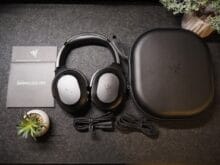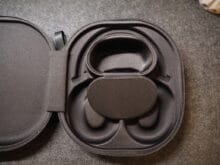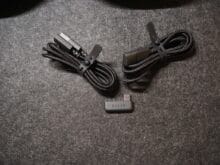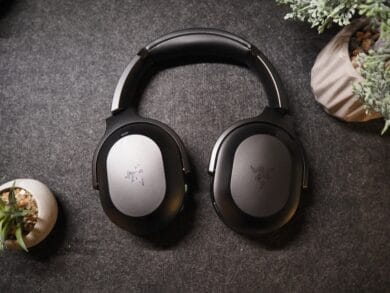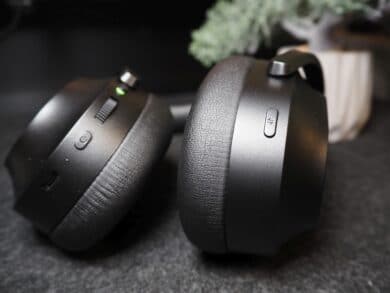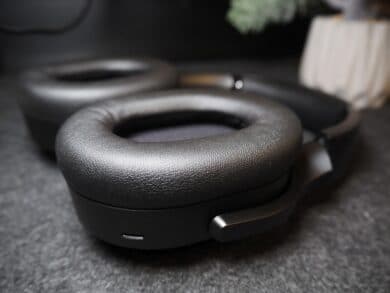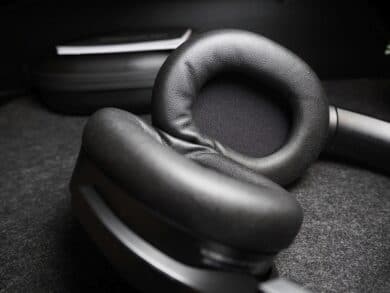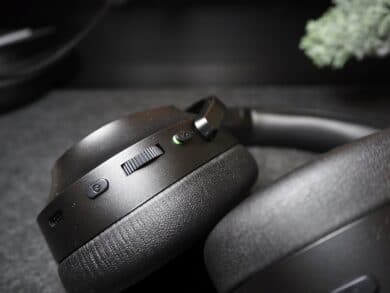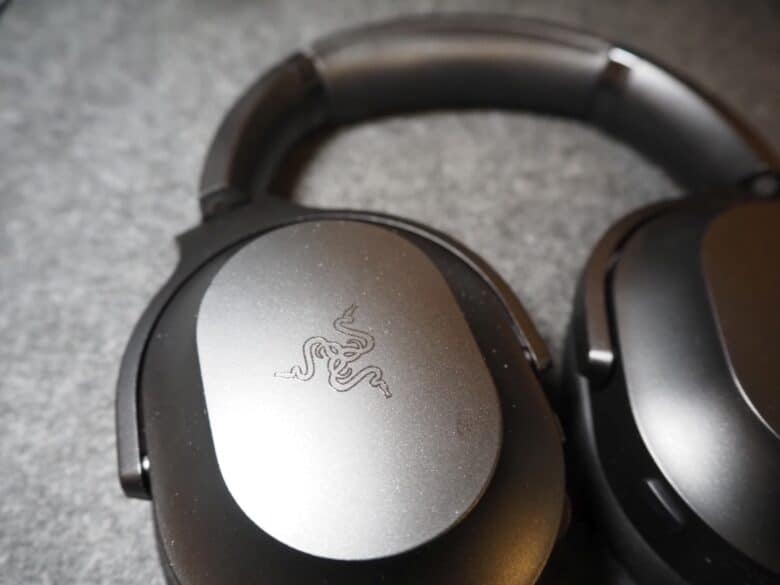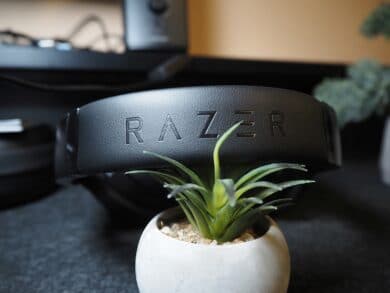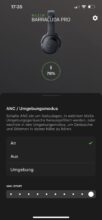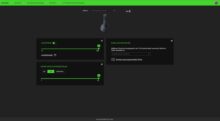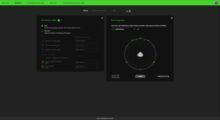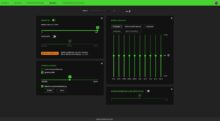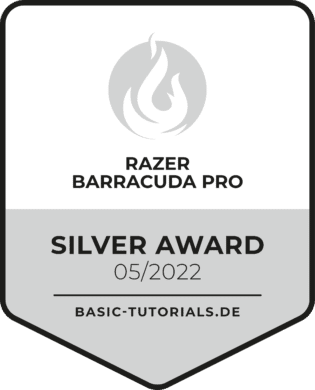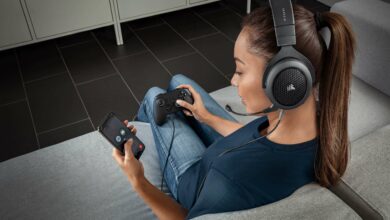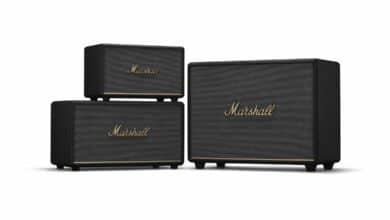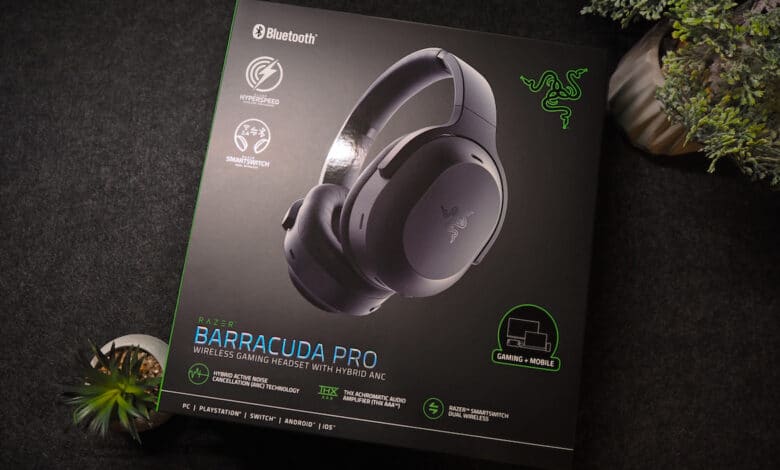
Razer has added a new Pro model to the Barracuda and Barracuda X (our review) gaming headsets this year, which hardly differs from a visual point of view, but from a technical point of view. Our Razer Barracuda Pro review reveals what you can expect and how good the gaming headset sounds.
Technical data
| Design | Over-ear |
| Driver | 50 mm (bio-cellulose) |
| Frequency range (headphones) | 20 – 20,000 Hz |
| Sensitivity (headphones) | 96 dBSPL / mW @1 kHz |
| Connectivity | Bluetooth 5.2, Wireless (USB dongle), USB-C to USB-A |
| Microphone type | MEMS; omnidirectional, with noise reduction |
| Sensitivity (microphone) | -38 +/-1 dB @1 kHz |
| Range (Wireless) | Circa 15 meters |
| Battery life | Up to 40 hours |
| Charge time | 4 hours |
| Weight | 340 g |
| Compatibility | PC, Mac, PlayStation 4, PlayStation 5, Xbox, Nintendo Switch, Smartphone, Tablet |
| Special features | Active noise cancellation (ANC), 7.1 surround sound; THX AAA amplifier |
| Price | 289.99 euros (RRP) |
Razer Barracuda Pro review: the scope of delivery
The Razer Barracuda Pro comes in the manufacturer’s typical packaging, though it is significantly larger than past headsets from the brand. A look inside also immediately reveals why.
We are first greeted by a high-quality transport hardcase in a glossy black imitation leather look, with the well-known snake logo emblazoned centrally on its lid. Via one of the two zippers, we get to the inside, where we find the headset itself alongside the obligatory instructions and notes.
Between the ear cups and headband, once again printed with Razer lettering, is another hidden compartment that houses the cables. Specifically, this is a USB-A to USB-C cable with a length of 1.5 meters, as well as another USB-C extension cable with the same length. The scope of delivery is rounded off by a small wireless receiver including a USB Type-C port.
Design and workmanship
Basically, the design of the Razer Barracuda Pro is based on the family members of the series. As such, it differs greatly from the look of the Kraken V3 HyperSense (our review). Once again, Razer goes for understatement here and presents a simple and classy gaming headset that comes without RGB lighting or flashy colors. Simple, glossy and matte-black elements go hand in hand (or not, since the Barracuda does not have a jack).
This means that the Pro model also offers voluminous, oval ear cups, where the generous and soft pads are particularly eye-catching. However, these are no longer made of fabric in the new top model of the series, but instead come in a plush faux leather look (Razer calls it “Plush-Letherette Memory Foam”).
The transition to the headband is seamless via the aluminum frame, which, unlike the X, is no longer silver, but with its dark gray (almost black) color scheme better suits the overall look of the headset.
On the bottom or inner sides of the ear cups, we find the controls of the Razer Barracuda Pro. On the left side, these are (from top to bottom): Mute button, volume wheel, power button and USB-C port. On the right, we find the SmartSwitch button on the inside, which is easily accessible – a new feature of the Pro model that has many functions. The microphone slots on the top of the ear cups, which are responsible for the headset’s new hybrid ANC technology, are also striking.
The Pro does without a microphone boom, just like the normal Barracuda. Once again, Razer relies on two MEMS microphones with noise cancellation, instead of a detachable HyperClear cardioid microphone.
Workmanship quality of the Razer Barracuda Pro
If the little brother already offered no reason for criticism, the workmanship of the Razer Barracuda Pro turns out even higher. This is not only due to the increased weight, which makes the gaming headset subjectively appear more robust, but mainly due to the choice of materials. First and foremost is the brushed aluminum headband, which combines flexibility and durability.
The ear cups of the Barracuda Pro can also be rotated, which of course makes transport (with or without a case) noticeably easier. The rotating mechanism is quite stable. All in all, the workmanship can fully convince.
Carrying comfort
Holy cow, is this thing comfortable! If Razer can be credited with one thing, it’s that the manufacturer’s headsets have undoubtedly been at the top in the field of wearing comfort in recent years. However, the Razer Barracuda Pro takes the crown.
This is hard to believe considering the weight, as the Pro model weighs in at a hefty 340 grams – almost 100g more than the X. The new plush leather memory foam ear cushions, or whatever you want to call them, are quite simply the softest and most comfortable representatives of their guild. Even after a gaming marathon or a full office day, the headset still rests comfortably over the ears.
The ear pads are a full two centimeters thick, and 1.5 cm for the headband padding. That speaks for itself. The enormously generous ear cups offer more than enough room inside, even for large eardrums. 65 mm in height and 45 mm in width are offered. That’s a good deal more than in the case of the Kraken V3 HyperSense. The Razer Barracuda Pro is also ahead in terms of the finely graduated rastering of the headband, as a whole 12 levels are offered here – the third Kraken “only” had eight levels.
Practical test and handling
Looks good, wears insanely comfortable. But how does the Razer Barracuda Pro do in the practical test? First of all, a small but fine detail deserves praise. The USB-C port of the 3.5 cm long wireless dongle has now moved to the edge (L-shape) and is no longer in the center (T-shape), unlike the Barracuda X. This allows for a more space-saving design. This allows for a more space-saving placement on the notebook or docking station.
The headset operates wirelessly in Bluetooth mode or, in combination with the dongle, in the 2.4 GHz band with particularly low latency. In both modes, the Barracuda Pro is quickly found by all of our tested devices and connects smoothly.
With the help of Razer SmartSwitch (we remember: the button on the right ear cup), switching between Bluetooth and wireless connection is done at the push of a button. For example, I can take a call on the PC and then immediately continue listening to music from the smartphone.
Conveniently, calls from the Bluetooth device come through automatically when I have the Razer Barracuda Pro connected to the PC and smartphone. So I can answer and make the call, while the headset switches directly back to PC sound afterwards. Without me having to set it down or press a button.
Bluetooth mode and more
Alternatively, a “do not disturb” mode can be activated on the software side, which blocks calls while gaming with 2.4 GHz without further ado. In addition, a gaming mode can be activated via Bluetooth and smartphone app, which further reduces the latency.
Wirelessly, the gaming headset achieves an excellent distance of around 15 meters to the audio source in both modes, even through thick walls. In any case, I was able to move around my entire apartment completely freely without the connection dropping out or sound dropouts occurring.
The fact that the Barracuda Pro is also only conditionally suitable as ANC headphones for listening to music on the go is also due to problems that the headphones reveal when it comes to impact sound. Even during normal walking, the audio quality suffers noticeably from the counter-sound of the steps.
Battery life and charging time
The battery life of the Razer Barracuda Pro is around 40 hours and is of course heavily dependent on the intensity of use and volume. Charging is done using the included USB-C cable, with a full charge taking around four hours. Of course, the headset can still be used while charging.

Recording and playback quality
Now it gets exciting, because up to this point the Razer Barracuda Pro was well on its way to the gaming headset throne. But how does it do sonically? First of all, the bare facts: Frequency band from 20 Hz to 20,000 Hz and an impedance of 32 ohms at 1 kHz – standard fare. Bluetooth codecs: SBC and AAC. THX Spatial Audio surround sound on (Windows PC). We already know all that.
And then, the first innovation. Razer relies on novel TriForce drivers made of bio-cellulose with a diameter of 50 millimeters in the Pro model. The organic compound is supposed to minimize “harmonic distortion” and let the music sound as it was intended by the artists. This is joined by a THX Achromatic Audio Amplifier (THX AAA), which is supposed to provide rich bass.
Sounds promising, but the sound was not completely convincing out-of-the-box. The Barracuda Pro is clearly too bass-heavy and pushes the lower trebles (and thus the overtones of human voices) a bit into the background, which swallows up details. This is the area where the hi-fi chaff separates from the wheat, after all, this area marks the greatest sensitivity of the ear.
The mids, on the other hand, are on a broad stage, minimally overemphasized perhaps, but this makes for a clear, direct sound. And yet: The sound cannot fully convince us in the standard settings. Especially since there is an enormous discrepancy between wireless and Bluetooth. In BT mode on the smartphone, the voices already seem extremely exaggerated at around 70% volume. Yes, downright unpleasantly sharp.
But wait, don’t throw in the towel just yet, because all flaws can be almost completely eliminated with the help of the extensive 10-band equalizer. Fine-tuning is really needed here to achieve a really convincing sound.
It should also be mentioned that Razer provided us with the final firmware of the headset during our test, which will also be distributed to end customers at release. All specifications and empirical values are already based on the updated version.
ANC and transparency mode
Active noise cancellation is becoming increasingly popular in the field of gaming headsets, which want to give washed-out over-ear headphones a run for their money here. Razer already relied on hybrid ANC in the Opus, and the EPOS H3PRO Hybrid we recently tested also relies on active noise cancellation.
Razer opted for a hybrid ANC for the new headset, which combines inward- and outward-facing microphones. However, the Barracuda Pro is at a disadvantage in a direct comparison with the aforementioned EPOS headset and real ANC over-ears. Especially low and constant noises are effectively suppressed, but typing on the keyboard, voices and other higher frequencies are more perceptible than in the case of the competition.
Furthermore, a constant, quiet background noise clouds the impression a bit. Even if only in quiet surroundings. Especially on the highest of the ten ANC levels. Basically, however, the ANC marks a real added value and ranks roughly on the level of good in-ear headphones.

On the other hand, we did not like the transparency mode, which amplifies ambient noise and voices. Here, the sound already seems distorted, which sometimes affects the intelligibility of the other person.
Microphone quality of the Barracuda Pro
The omnidirectional microphone of the Razer Barracuda Pro is also not completely convincing. This once again shows the weakness of MEMS microphones, which simply do not react as sensitively as corresponding counterparts due to the lack of a microphone arm.
As a result, the headset just doesn’t perceive quieter sounds or syllables and chops them off. The given quality is absolutely sufficient for the one or other short conversation, but not for more. The user’s own voice also does not sound really dynamic. Although additional software settings can be made, the headset does not achieve a really good quality. Even a cheap gaming headset like the Corsair HS65 Surround (our review) is clearly ahead here.
Software connectivity: Razer Synapse / Razer Audio
For fine-tuning, the Barracuda falls back on the familiar Synapse software on the PC and the Razer Music app on the smartphone. As always, the connection of a new Razer peripheral is accompanied by a software update, which subsequently gives us access to various functions.
Basically, both software solutions offer a quite similar and quite high feature set. The mobile app informs us about the battery status on the home page and lets us directly activate or deactivate the “Do Not Disturb” and gaming modes. We can also directly adjust or deactivate the microphone’s noise cancellation in two stages.
We can adjust the ANC in a total of ten levels, while the sound can be fine-tuned via the equalizer. Alternatively, a total of four presets are available here.
It looks quite similar on the PC. Whereby the adaptation of the THX Spatial Audio sound including different surround sound modes is added here. We can even set these individually for single games or applications.
In addition, we can adjust the playback and recording quality in much more detail and, if desired, add a bass boost, audio normalization or an improvement of the speech quality, for example.
In addition to volume, voice gate and various enhancements, there are also a total of four EQ presets to choose from for the microphone, while we are also able to lend a hand here in a total of 10 bands. Thanks to the mic preview, we can also hear directly in the program how the sound changes. Grandiose, no other accompaniment software offers such extensive setting options.
Razer Barracuda Pro Test: Conclusion
In the Razer Barracuda Pro review, the manufacturer’s new gaming headset reveals a lot of light, but also a surprising amount of shadow. The headset can score points especially in the noble design, the high-quality workmanship and the excellent wearing comfort. I have never had a more comfortable headset on my head.
The connection works flawlessly with several devices and the change is done in seconds at the push of a button. Add to that extremely versatile companion software, good (but by no means outstanding) ANC, and rich surround sound.
However, some fine-tuning is required to make the Barracuda Pro sound really good. Unlike the manufacturer’s last headsets, I don’t really like the standard sound, especially in Bluetooth mode. In addition, the microphone quality is not completely convincing.
Considering the features offered, the RRP of around 290 Euros is quite fair for such a versatile all-rounder that no competitor can hold a candle to, especially in terms of wearing comfort. Those who can do without the ANC function or need a really good microphone will be better served elsewhere.
Razer Barracuda Pro
Workmanship
Comfort
Sound quality
Recording quality
Features
Value for money
89/100
Extremely versatile and high-quality gaming headset with excellent wearing comfort, ANC and surround sound. The sound quality needs a lot of fine-tuning, but the microphones are not convincing.



